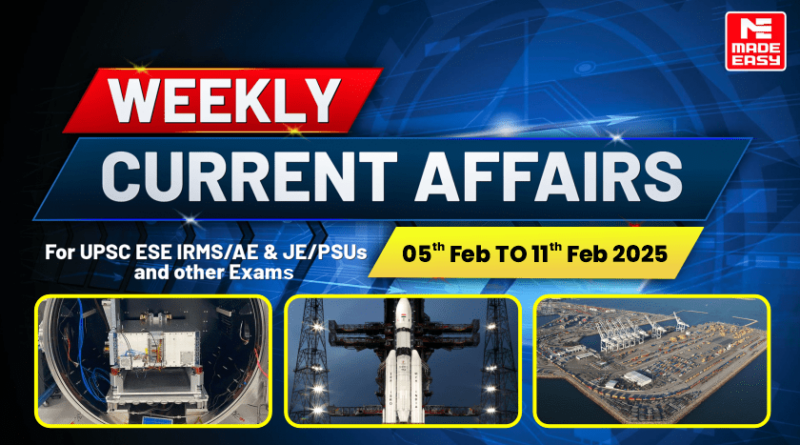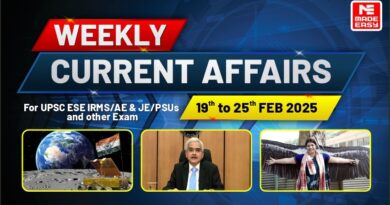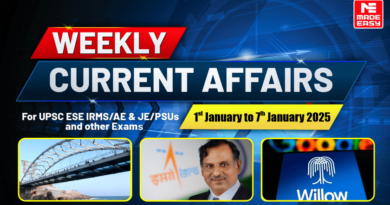5 to 11 February 2025 Weekly Current Affairs
MADE EASY Last Week Current Affairs: 29th JAN to 4th FEB 2025
Candidates preparing for government exams in India prioritize current affairs, as this section is frequently included in both technical and non-technical exams to assess general awareness. Given its importance, MADE EASY brings you the Weekly Current Affairs (5th to 11th February 2025) to help you stay updated. Mastering current affairs through regular study can significantly enhance your exam performance. Stay informed and boost your preparation with MADE EASY!
To simplify your exam preparation, MADE EASY brings you the Weekly Current Affairs (5th to 11th February 2025) to boost your GS score. This comprehensive resource covers all major national and international events, helping aspirants stay updated while saving valuable preparation time.
In this edition of MADE EASY Last Week Current Affairs, you will read about: Chabahar Port, US Withdrawal from International Forums, Chandrayaan-4, Pinaka, India’s Single Largest Solar Cell Making Unit, e-National Agricultural Market (e-NAM), National Commission for Safai Karamcharis, TROPEX, Fort William, CE20 Cryogenic Engine, Cyclone 2025, Shiv Shakti Point, Pandora Mission, PM-AJAY Scheme, European Free Trade Association (EFTA), Paris AI Summit, Exercise Winged Raider and much more!
Mastering these key topics will enhance your Current Affairs score. Stay updated and strengthen your exam preparation with MADE EASY!
5 to 11 February 2025 Weekly Current Affairs for UPSC CSE, ESE, RRB & SSC JE
Chabahar Port: 5 February 2025
Context: The US government is currently reviewing the sanctions waiver granted to India for the Chabahar Port project, which could impact India’s connectivity plans with Central Asia.
Background
- The United States has imposed multiple rounds of sanctions on Iran, primarily targeting its nuclear program and economic activities.
- US Sanctions Waiver for Chabahar: The US granted a waiver for India’s involvement in Chabahar. The key aspects of the waiver include:
- First Waiver: In 2018 the US exempted India from sanctions related to Chabahar, acknowledging its humanitarian and regional connectivity benefits.
- Renewed Waiver: Further exemptions were granted, ensuring continued Indian operations at the Shahid Beheshti Terminal and related connectivity projects.
Impact of US Sanctions on India
- The new US directive restricts India’s ability to continue its operations at Chabahar port. Despite US sanctions on Iran, India continues to import oil from Russia amid growing global pressure.
- Since 2018, the port has handled over 90,000 TEUs (twenty-foot equivalent unit) of container traffic and more than 8.4 million metric tons of cargo.
- The earlier sanctions have led to a significant decline in India’s trade with Iran. In 2018-19, India’s imports from Iran were worth $13 billion, primarily crude oil. However, post-2019, imports fell to less than $1 billion annually.
About Chabahar Port
- Iran’s Chabahar port is located on the Gulf of Oman and is the only oceanic port of the country.
- It is situated in the city of Chabahar in Sistan and Baluchestan Province.
- Chabahar has two ports; Shahid Kalantari and Shahid Beheshti.
- The former is an old port with limited water front to accommodate feeder vessels.
- The Shahid Beheshti Port is being developed in four phases. On completion of all 4 phases, port capacity will be 82 million tons per year.
US Withdrawal from International Forums: 5 February 2025
Context: The United States has recently announced its withdrawal from several key international organizations, including the UNHRC, the WHO, and other international forums.
Key Facts
- United Nations Human Rights Council (UNHRC): US cited the UNHRC’s ‘chronic bias against Israel’ and its failure to address genuine human rights concerns.
- It was part of a broader pattern of the Trump administration stepping back from international agreements and organizations under its ’America First’ policy.
- It accused the UNHRC of ‘obsessively demonizing the one democracy in the Middle East’ and propagating antisemitism.
- The US prohibits any future funding for the United Nations Relief and Works Agency (UNRWA), which provides aid to millions of Palestinians.
- It is important to note that the UNHRC has passed over 100 condemnatory resolutions against Israel, which amounts to more than 20% of all resolutions passed by the council.
- World Health Organization (WHO): Reasons behind withdrawal are WHO’s handling of the COVID-19 pandemic and its perceived bias towards China.
- The US, being the largest financial contributor to the WHO, argued that the organization needed to be reformed to better serve its member states.
- It could cost WHO $130 million in annual funds and hinder global public health response.
- The US has reviewed its involvement in other international organizations, such as UNESCO and the Paris Climate Accord, citing ‘wild disparities’ in financial contributions among member countries.
- Earlier, US left UNESCO in 2017, citing an alleged anti-Israel bias within the organization. It echoed a similar withdrawal in 1984 under President Ronald Reagan, which was reversed in 2003.
- The US withdrew from the Trans-Pacific Partnership (TPP) in 2017, citing the need to protect American jobs and industries.
- The remaining countries proceeded with a revised version called the Comprehensive and Progressive Agreement for Trans-Pacific Partnership (CPTPP).
Chandrayaan-4: 6 February 2025
Context: India will launch the Chandrayaan-4 mission to bring back samples of moon rocks to the Earth in 2027.
Key Highlights
- Chandrayaan-1: It was launched in 2008 and was India’s first lunar mission. It made India the fifth country to reach the Moon.
- The mission’s most significant discovery was the presence of water molecules on the lunar surface, a finding confirmed by NASA.
- Chandrayaan-2: It was launched in 2019 with an orbiter, a lander (Vikram), and a rover (Pragyan).
- The mission aimed to achieve a soft landing on the lunar surface, but ISRO lost contact with the lander just before touchdown, resulting in a crash landing.
- Despite this setback, the orbiter continued functioning and provided crucial data on the Moon’s surface and atmosphere.
- Chandrayaan-3: A follow-on mission to Chandrayaan-2, successfully achieved a soft landing on the Moon’s south pole in 2023.
- Lander payloads: Chandra’s Surface Thermophysical Experiment (ChaSTE) to measure the thermal conductivity and temperature; Instrument for Lunar Seismic Activity (ILSA) for measuring the seismicity around the landing site etc.
- Rover payloads: Alpha Particle X-ray Spectrometer (APXS) and Laser Induced Breakdown Spectroscope (LIBS) for deriving the elemental composition in the vicinity of landing site.
Pinaka: Multiple Rocket Launch Systems (MRLS): 6 February 2025
Context: The Union Defence Ministry signed contracts worth ₹10,147 crore for ammunition to enhance the Army’s Pinaka Multiple Rocket Launch Systems (MRLS).
Key Highlights
- The contracts, with Economic Explosives Limited (EEL) and Munitions India Limited (MIL), involve procuring Area Denial Munition (ADM) Type-1 and High Explosive Pre-Fragmented (HEPF)-Mk-1 rockets, respectively.
- These advanced munitions will improve the Pinaka’s range and firepower.
About Pinaka
- The Pinaka rocket system has been developed by Armament Research and Development Establishment, Pune supported by High Energy Materials Research Laboratory, another Pune-based laboratory of DRDO.
- The Pinaka Mk1 has a range of 38 km and it can fire a variety of ammunition.
- The upgraded Pinaka system, which is becoming the Army’s primary long-range artillery, has already completed successful flight tests of guided rockets with a 75 km range, with plans to extend the range to 120 km and 300 km.
- The Pinaka MLRS can fire 72 rockets in 44 seconds, with four regiments in service and six more ordered.
- Armenia became the first export customer for the indigenously developed Pinaka with interest expressed by several countries in the system.
- The Indian Army has four Pinaka regiments in service and six more are on order.
India’s Single Largest Solar Cell Making Unit: 6 February 2025
Context: The CM of Tamil Nadu inaugurated India’s single largest solar cell and module manufacturing unit at the Gangaikondan SIPCOT Industrial Growth Centre.
Key Highlights
- The Gangaikondan SIPCOT Industrial Growth Centre is an industrial park in the village of Gangaikondan, Tirunelveli, Tamil Nadu.
- It was set up by Tata Power’s solar energy manufacturing arm, TP Solar Limited.
- The facility would produce photovoltaic cells and modules for solar power generating units having an annual capacity of around 4 GW.
- The unit will produce mono of 182mm and multi-crystalline cells of 158.25 mm sizes.
e-National Agricultural Market (e-NAM): 7 February 2025
Context: The Union Agriculture Minister has announced plans to upgrade the National Agricultural Market (e-NAM) to e-NAM 2.0 to resolve logistical hurdles in inter-state and inter-mandi trade.
About e-NAM
- e-NAM is a pan-India electronic trading platform that connects Agricultural Produce Market Committee (APMC) mandis to create a unified national market for agricultural commodities.
- It is implemented by the Small Farmers Agribusiness Consortium (SFAC) under the Ministry of Agriculture & Farmers’ Welfare (MoA&FW).
- It provides digital services to traders, farmers, Farmer Producer Organizations (FPOs), and Mandis.
- As of December 31, 2024, 1.79 crore farmers and 2.63 lakh traders have registered on the platform.
Key Features of e-NAM 2.0
- Unified Logistics Interface Platform (ULIP) integration for real-time tracking of produce.
- Optimized freight options to reduce transit times and improve delivery efficiency.
- Expanded Warehousing and Cold Storage Infrastructure: The Agricultural Infrastructure Fund (AIF) will offer subsidized loans to promote private investment in storage facilities.
- AI and Machine Learning (ML) to suggest fair market prices.
- Automated quality testing to minimize disputes over product grading.
- Direct bank transfers and e-wallets for quick settlements.
- Fintech partnerships to provide micro-loans based on transaction history.
- Introduction of a unified digital pass to ease regulatory compliance.
- Standardized tax & compliance framework to facilitate free movement of produce.
- Voice-based commands and local language options on the e-NAM app.
- Digital literacy campaigns to help farmers navigate the platform.
National Commission for Safai Karamcharis: 7 February 2025
Context: The Union Cabinet has approved the extension of the National Commission for Safai Karamcharis (NCSK) tenure until March 31, 2028, with a financial implication of around Rs 51 crore.
About National Commission for Safai Karamcharis (NCSK)
- It was established on 12th August 1994 under the National Commission for Safai Karamcharis Act, 1993, initially for a period of 3 years as a statutory body.
- The Act was extended until 2004, after which the Commission became a non-statutory body under the Ministry of Social Justice and Empowerment.
- The Commission takes suo-motu notice of issues affecting Safai Karamcharis based on media reports or observations.
- The Commission consists of a Chairperson (Union Minister of State rank), a Vice-Chairperson (Secretary rank), five members (including one woman member), and a Secretary (Joint Secretary rank).
- Mandate of the Commission: Recommend programs for the elimination of inequalities for Safai Karamcharis (sanitation workers).
- Evaluate and study social and economic rehabilitation programs for Safai Karamcharis and scavengers.
- Monitor working conditions (health, safety, wages) of Safai Karamcharis employed by various employers, including government bodies.
- Expanded Mandate (Post-2013): Following the enactment of “The Prohibition of Employment as Manual Scavengers and Their Rehabilitation Act, 2013”, the Commission’s scope expanded to Monitor implementation of the Act.
- Take suo-motu notice of non-implementation of the Act.
- Supreme Court Judgment (2023): The Commission monitors the implementation of Supreme Court directives to eliminate manual scavenging.
- Directive involves the compensation, rehabilitation measures and establishment of accountability mechanisms related to manual scavenging.
TROPEX: 7 February 2025
Context: The 2025 edition of Indian Navy’s Theatre Level Operational Exercise (TROPEX) held in the Indian Ocean Region.
Key Highlights
- The exercise is conducted biennially and spans three months (January-March 2025).
- Participants: All operational Indian Naval units, along with Indian Army, Air Force, and Coast Guard assets.
- Approximately 65 Indian Naval Ships, 9 Submarines, and over 80 Aircraft of various types are participating.
- Objective: The exercise has grown in scope and complexity over the years.
- It focuses on coordinated planning, precise targeting, combat effectiveness, and credible joint operations.
- It aims to validate the Indian Navy’s core warfighting skills.
- It also aims to ensure a synchronized, integrated response for national maritime security against conventional, asymmetric, and hybrid threats.
Fort William: Vijay Durg: 8 February 2025
Context: Fort William in Kolkata, the headquarters of the Eastern Army Command, has been renamed Vijay Durg.
About Fort William
- The first Fort William was constructed by the British East India Company in 1696 along the eastern banks of the Hooghly River.
- It was named after King William III of England.
- The fort is known for its irregular octagonal structure and arched windows. There are six gates: Chowringhee, Plassey, Calcutta, Water Gate, St Georges and the Treasury Gate. The Maidan, the largest park in India, is located in front of the fort.
- In 1756, Nawab Siraj-ud-Daulah of Bengal attacked and captured the fort, leading to the infamous ‘Black Hole of Calcutta’ incident.
- After the British regained control following the Battle of Plassey (1757), a new and more fortified structure was built between 1758 and 1781 under the command of Robert Clive.
CE20 Cryogenic Engine: 8 February 2025
Context: The Indian Space Research Organisation (ISRO) successfully conducted an ignition trial of the CE20 cryogenic engine.
Key Highlights
This engine powers the upper stage of the Launch Vehicle Mark-3 (LVM3). The test took place at the High-Altitude Test Facility in Mahendragiri, Tamil Nadu.
Significance of the CE20 Engine
- The CE20 engine is essential for the Gaganyaan mission.
- It is designed to operate under vacuum conditions and can generate thrust levels between 19 tonnes to 22 tonnes.
- The engine’s successful ignition is milestone in India’s space exploration efforts.
About Gaganyaan
- Gaganyaan is India’s first human spaceflight mission by ISRO.
- It aims to send astronauts to a 400 km low Earth orbit for three days and bring them back safely.
- If successful, India will be the fourth country to send humans to space after the US, Russia, and China.
Spacecraft & Launch Vehicle
- Gaganyaan consists of:
- Crew Module (for astronauts).
- Service Module (for essential systems).
- It will be launched using GSLV Mk III (now called LVM-3), India’s most powerful rocket.
Human Spaceflight Details
- The spacecraft will reach orbit in 16 minutes.
- It will orbit Earth every 90 minutes.
- The crew module is 3.7m wide and 7m tall.
- Orange space suits designed by Vikram Sarabhai Space Centre can provide oxygen for 1 hour in emergencies.
- The return journey will take 36 hours, landing in the Arabian Sea near Gujarat.
Exercise ‘Cyclone 2025’: 8 February 2025
Context: Exercise ‘Cyclone 2025’ began at the Mahajan Field Firing Range in Rajasthan.
About Cyclone 2025
- It is a joint military exercise between India and Egypt. The first edition of the exercise was conducted in 2023 in India.
- It is a 14-day exercise which aims to enhance defence cooperation by sharing professional skills and improving interoperability of special forces in desert environments.
Shiv Shakti Point: 9 February 2025
Context: The Chandrayaan-3 mission’s landing site, known as Shiv Shakti point, is estimated to be around 3.7 billion years old. This age coincides with the emergence of primitive microbial life on Earth.
About Chandrayaan-3
- Chandrayaan-3 is India’s third lunar exploration mission, launched by the Indian Space Research Organisation (ISRO).
- The mission aimed to explore the moon’s surface, particularly the south pole region.
- The Vikram lander and the Pragyan rover were key components of this mission. They provided crucial data about the lunar surface and its geological history.
Age Estimation of the Landing Site
- Scientists from ISRO’s Physical Research Laboratory conducted a detailed analysis of the landing site.
- They used high-resolution imaging techniques to study the crater and rock distribution.
- The age of the region was established by examining 25 craters, revealing an age of approximately 3.7 billion years.
- This was corroborated by studying additional craters in the vicinity.
Geological Features of the Landing Site
- The Shiv Shakti point is characterised by diverse terrain types.
Researchers identified three distinct terrain types – high-relief rugged terrain, high-relief smooth plains, and low-relief smooth plains. - The landing site itself is situated in the low-relief smooth plains, which were determined to be the oldest among the studied terrains.
- The Pragyan rover’s exploration revealed a diverse range of rock samples.
- Among the 5,764 rocks examined, 525 measured over 5 metres in length.
- Notably, the largest rocks were found near a fresh crater, indicating that this area had experienced less space weathering.
- This fresh crater, located 14 km south of the landing site, provides vital information about the geological processes at play.
Pandora Mission: 9 February 2025
Context: NASA’s upcoming mission, Pandora, is set to launch in 2025.
Key Highlights
- This mission aims to study the atmospheres of distant exoplanets.
- With the James Webb Space Telescope (JWST) facing overwhelming demand for observation time, Pandora will fill a critical gap. It will focus on clouds, hazes, and water, which are essential for assessing habitability in distant worlds.
- Pandora will utilise a 17.7-inch (45 cm) aperture Cassegrain telescope. Although smaller and less sensitive than JWST, its design allows for prolonged observations.
- The mission will employ the transit method to capture starlight filtering through exoplanet atmospheres, revealing critical chemical signatures.
Mission Objectives
- Analyzing the atmospheres of at least 20 exoplanets, primarily gas giants and super-Earths.
- Investigating the presence of key atmospheric components like water vapor, methane, and carbon dioxide.
- Monitoring stellar activity to understand its impact on observations.
- Supporting data collection for JWST and other missions to enhance exoplanet models.
- Demonstrating the capabilities of small satellites in astrophysics
About Exoplanets
- Exoplanets are planets that orbit stars outside our solar system.
- They provide vital information about planetary formation and the potential for life beyond Earth.
- NASA has confirmed over 5,800 exoplanets, but many remain unstudied due to the complexities involved in atmospheric analysis.
PM-AJAY Scheme: 10 February 2025
Context: The Union Government reviews progress of PM-AJAY scheme, emphasizes inclusive growth for SC communities.
About PM-AJAY Scheme
- PM-AJAY is a Central sponsored scheme launched in 2021 for the upliftment of Scheduled Caste (SC) communities in India.
- Objectives: Reduce poverty through skill development and income-generating initiatives.
- Increase literacy rates and encourage SC enrolment in educational institutions, especially in aspirational districts.
- Core Components:
- Adarsh Gram Development: Converts SC-majority villages into model villages with integrated development.
- Focuses on essential infrastructure and socio-economic progress across ten domains, including education, healthcare, and financial inclusion.
- Grants-in-Aid: Funds district and state-level projects for SC livelihood development.
- Supports sustainable income opportunities for SC communities.
- Hostel Construction: Establishes hostels to support SC students in accessing quality education.
- Aims to reduce dropout rates and promote higher education.
- Adarsh Gram Development: Converts SC-majority villages into model villages with integrated development.
European Free Trade Association (EFTA): 10 February 2025
Context: Two of the four-member European Free Trade Association (EFTA) countries—Switzerland and Liechtenstein—are pushing for a bilateral investment treaty (BIT) with India.
Key Highlights
- EFTA signed a trade agreement with India last year, committing to a $100 billion investment over 15 years.
- Switzerland is the largest trading partner of India among the countries in the EFTA region.
- Last year, Switzerland suspended the Most-Favoured-Nation (MFN) clause in the Double Taxation Avoidance Agreement (DTAA) originally signed between India and Switzerland in 1994.
About European Free Trade Association (EFTA)
- EFTA is the intergovernmental organisation of Iceland, Liechtenstein, Norway and Switzerland.
- It was set up in 1960 by its then seven Member States for the promotion of free trade and economic integration between its members.
- In 2022, the combined EFTA-India merchandise trade surpassed USD 6.1 billion. The primary imports to the EFTA States consisted of organic chemicals (27.5%), while machinery (17.5%) and pharmaceutical products (11.4%), constituted the main exports to India.
Market Intervention Scheme: 10 February 2025
Context: The Ministry of Agriculture & Farmers’ Welfare has revised guidelines for the Market Intervention Scheme (MIS).
About Market Intervention Scheme (MIS)
- Market Intervention Scheme is a component of the PM-AASHA scheme.
- It is implemented on the request of the State/UT Government for procurement of various perishable agricultural/horticultural commodities such as tomato, onion and potato etc. for which Minimum Support Price (MSP) is not applicable.
Revised MIS Guidelines
- MIS will be implemented only when there is a minimum reduction of 10% in the prevailing market price as compared to the previous normal year.
- The procurement/coverage limit of production quantity of crops has been increased from the existing 20 percent to 25 percent.
- The State has also been given the option to pay the difference between the Market Intervention Price (MIP) and the selling price directly into the bank account of the farmers in place of physical procurement.
Paris AI Summit: 11 February 2025
Context: The Paris AI Summit was co-chaired by India and France at the Grand Palais, Paris.
Key Highlights
First AI Summit (2023, UK) & Bletchley Park Declaration
- Known as the AI Safety Summit.
- 28 countries, including India, US, UK, EU, and China, signed the Bletchley Park Declaration.
- The declaration aimed to regulate Frontier AI systems (advanced AI) to prevent misuse (terrorism, crime).
Second AI Summit (2024, Seoul)
- 16 major AI companies pledged to develop AI with transparency.
- It highlighted the need for responsible AI development.
Third AI Summit (2025, Paris)
Jointly chaired by PM Narendra Modi and French President Emmanuel Macron, it witnessed the participation of over 90 countries.
Main Goals of the Summit
- Make AI independent, safe, and accessible to everyone.
- Develop environmentally friendly AI.
- Create a global AI governance system that is effective and inclusive.
Key Themes Discussed
- AI in public services.
- Future of work and AI’s impact.
- Innovation and AI’s role in culture.
- Building trust in AI.
- Global governance of AI.
Exercise Winged Raider: 11 February 2025
Context: The Indian Army recently completed training exercise named Ex Winged Raider.
Key Highlights
- Ex Winged Raider focused on special airborne operations and brought into light the importance of inter-service collaboration.
- Conducted in the Eastern Theatre, the exercise showcased the Indian Army’s and Indian Air Force’s (IAF) commitment to enhancing their operational readiness and synergy.
- Airborne operations play a vital role in modern military strategy. They enable swift and decisive action, essential for responding to evolving security challenges.
- The exercise allowed troops to refine their skills, ensuring they are prepared for any contingency.
About Ex Winged Raider
- Ex Winged Raider aimed to improve the capabilities of both the Indian Army and the IAF.
- It involved rehearsing various airborne insertion techniques using both fixed-wing and rotary-wing aircraft.
- This training is crucial for ensuring troops can be rapidly deployed in diverse operational environments.
Mass Drug Administration (MDA) Campaign: 11 February 2025
Context: Recently, the Government of India launched an ambitious campaign aimed at the elimination of Lymphatic Filariasis (LF).
Key Highlights
- The initiative, known as the Annual Nationwide Mass Drug Administration (MDA) Campaign, was inaugurated by Union Minister for Health and Family Welfare.
- This campaign seeks to tackle LF, a debilitating parasitic disease, through comprehensive strategies across 111 endemic districts in 13 states.
About Lymphatic Filariasis
- Lymphatic Filariasis, commonly referred to as “Hathi Paon,” is caused by parasitic worms transmitted by infected mosquitoes.
- The disease can lead to severe physical disabilities like lymphoedema and hydrocele, affecting the quality of life.
- LF poses long-term health burdens on individuals and families, necessitating urgent intervention.
Objectives of the MDA Campaign
- The MDA campaign aims to administer anti-filarial medications to all eligible individuals in LF-endemic areas.
- The primary objective is to achieve over 90% coverage among the population, thereby halting the transmission of the disease.
- The campaign is designed to be inclusive, ensuring no one is left out during the distribution of medications.
To read all the current affairs of the last year, click on the link below:
🔗Download the Complete Current Affairs PDF for Free Now!
Must Read: 🔗 Weekly Current Affairs: 29 JAN to 4th FEB 2025
MADE EASY Offline and Online Courses
| MADE EASY Classroom & Live-Online Courses: Enroll Now 👇 | |
|---|---|
Classroom Courses |
|
| GATE | GATE+ESE |
| GATE+SES | GATE+ESE+SES |
| Conventional Course | Offline Test Series |
| G.S. & Engg. Aptitude Batch | Interview Guidance |
Live-Online Courses |
|
| GATE+SES | GATE+ESE |
| GATE+ESE+SES | JE & AE |
| Rank Improvement Course | RRB-JE |
| UPPSC-AE | State Exams (GS) Course |
Are you looking for Current Affairs 2024?
If yes then buy the book given below today and strengthen your exam preparation.
- Book Name: Current Affairs Quarterly Issue: July-August-September 2024
- Publisher Name: MADE EASY Publications
- MRP: ₹ 200.00
- Price: ₹ 170.00 (15% OFF)






